What is one of the most overlooked yet powerful aspects of your organization? It’s likely to be the employee life cycle. This concept covers the employee experience as new candidates go from interview to onboarding and offboarding.
Each step influences how your organization is viewed by existing staff, new hires, and, crucially, departing employees. Your organization will thrive by incorporating the employee life cycle into all business processes.
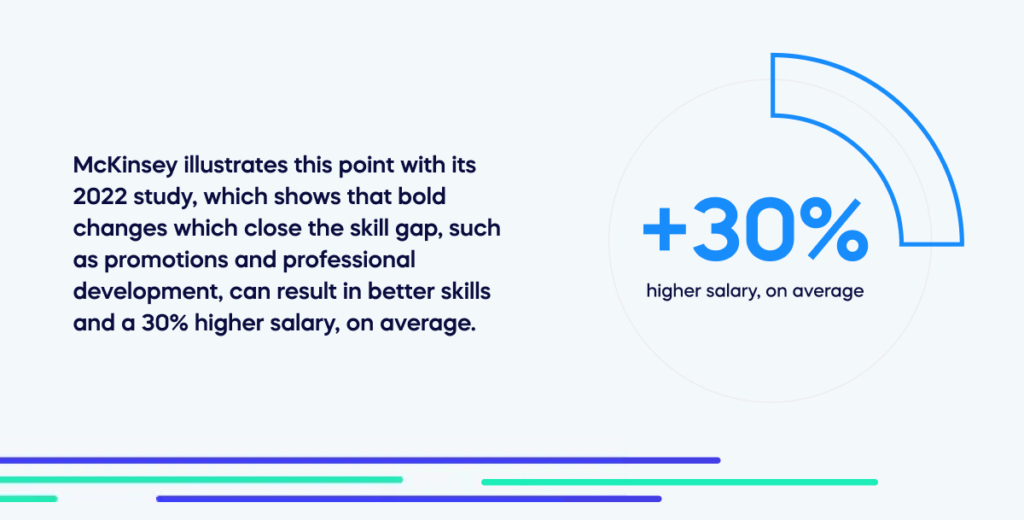
McKinsey illustrates this point with its 2022 study, which shows that bold changes which close the skill gap, such as promotions and professional development, can result in better skills and a 30% higher salary, on average. These bold changes can lead to staff remaining or departing a company, highlighting the importance of successful employee life cycle management.
These points form the basis for this article, covering the following aspects of the employee life cycle:
- What is the employee life cycle?
- Who does the employee life cycle impact?
- Why design an employee life cycle strategy?
- What Are the Six Stages of the Employee Life Cycle Model?
Let’s begin with a definition.
What is the employee life cycle?
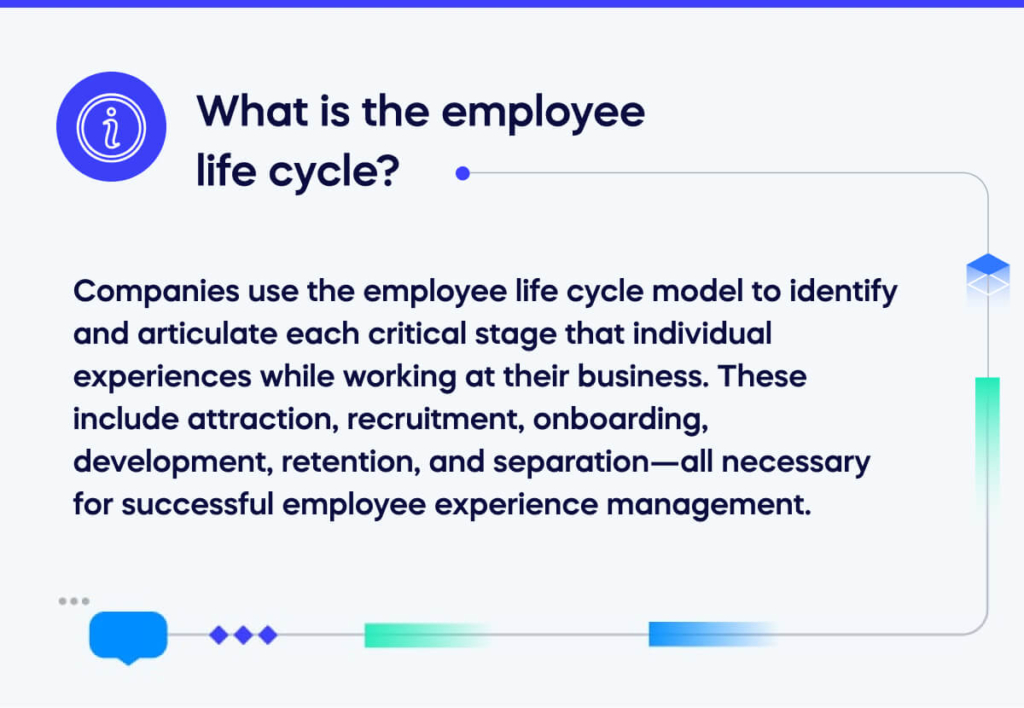
Companies use the employee life cycle model to identify and articulate each critical stage that individual experiences while working at their business. These include attraction, recruitment, onboarding, development, retention, and separation—all necessary for successful employee experience management.
Who does the employee life cycle impact?
Everyone is the short answer to who impacts the employee life cycle. When an employee goes through the life cycle stages, other employees observe the process, coloring their perception of the organization, which often influences decisions to stay or depart.
The life cycle also impacts the employer when employees make decisions about working toward promotions or departing. And finally, the life cycle implications for c-suites who are under pressure to ensure employees receive the best experience as part of their employee life cycle management responsibilities so staff continue to work there.
These are why it is essential for staff at every level, including CEOs, to understand the importance of the employee life cycle: An organization includes individuals who need support and a positive experience to encourage them to remain at their organization long term.
Why design an employee lifecycle strategy?
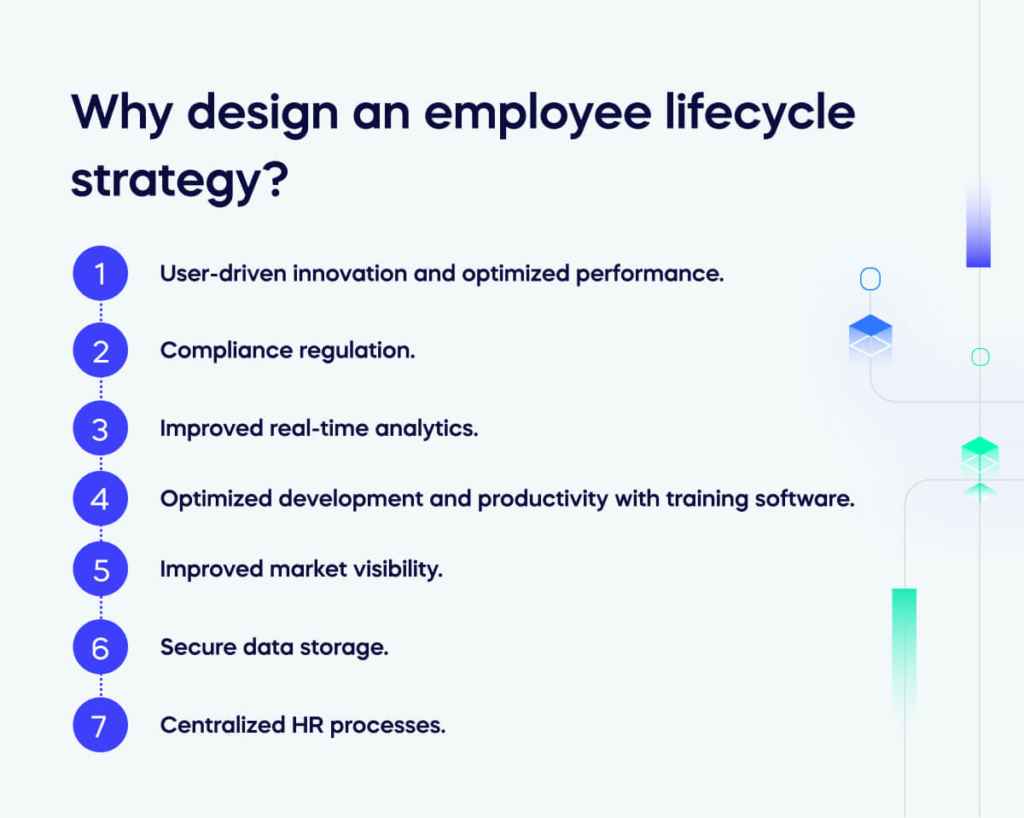
The employee life cycle model is critical to the success of each employee’s journey, as it pushes you to assess and enhance the experience of your employees during each stage. When workers have a positive experience with your business, they will be more inclined to stay employed with you – raising retention levels drastically while reducing turnover costs.
- User-driven innovation and optimized performance.
- Compliance regulation.
- Improved real-time analytics.
- Optimized development and productivity with training software.
- Improved market visibility.
- Secure data storage.
- Centralized HR processes.
To design an employee life cycle strategy, you must first know the six stages of this cycle.
What are the 6 stages of the employee life cycle model?
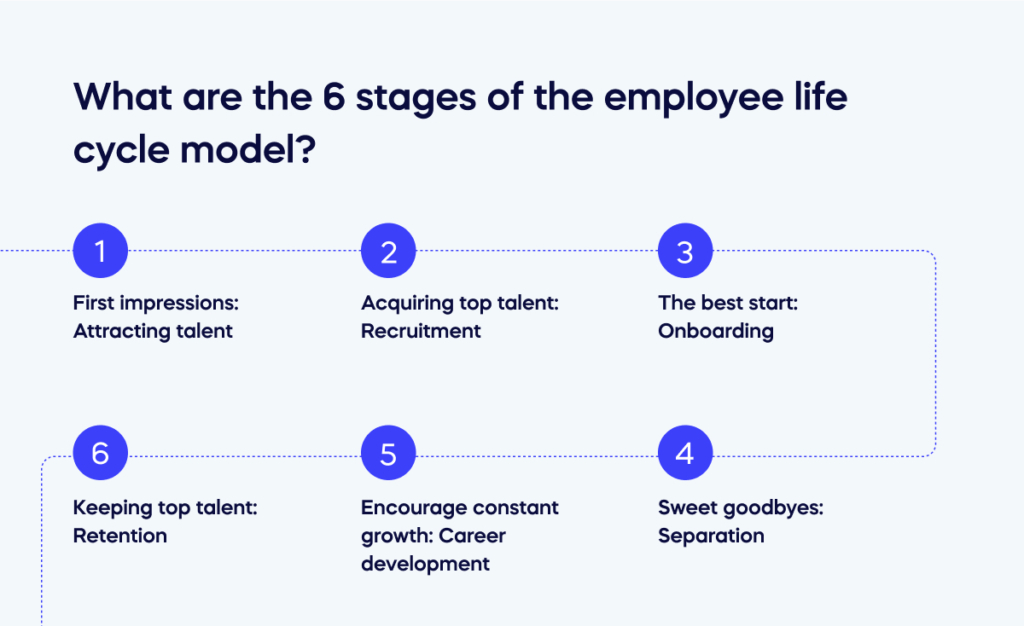
Knowing the six stages of the employee life cycle will ensure you give your staff the best employee experience. The first of these stages involves first impressions as you begin to attract talent to your organization.
1. First impressions: Attracting talent
Your relationship with an employee begins long before they come to work. It is the first time they hear about your company through employer branding. That is when the relationship starts.
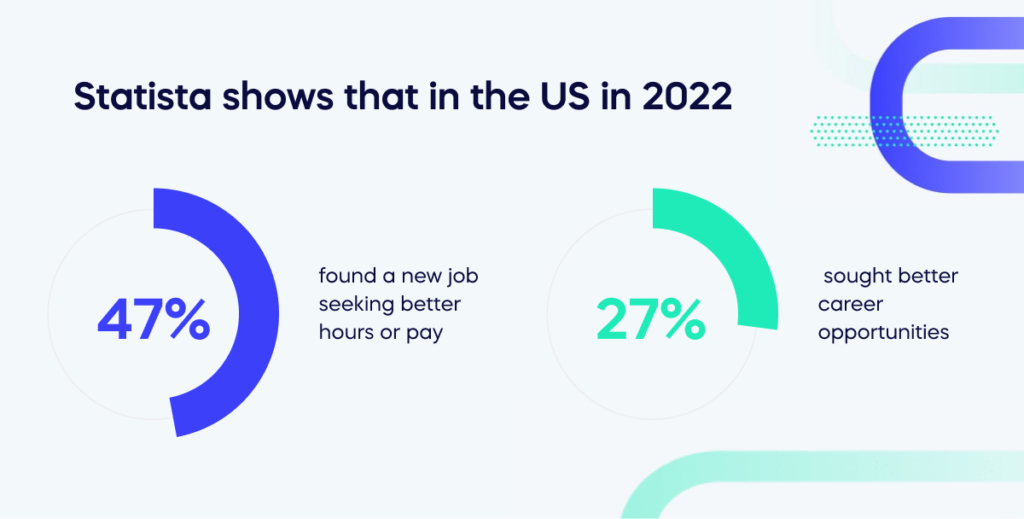
Statista shows that in the US in 2022, 47% found a new job seeking better hours or pay, and 27% sought better career opportunities. Anticipate and negate these reasons for employees to depart by knowing what is important to them and delivering on these needs.
HR leaders know it is essential to make a good company culture. The cultural web model shows how rules and stories can affect how people work together. Show this culture to others as you advertise your employer brand’s positives. Candidates will want to work for you because of your salary, job title, and how they feel about your brand.
Best approach:
Testimonies from past or present employees are invaluable, which might explain why GlassDoor remains so popular. But forward-thinking job applicants will also study other aspects of your organization, such as your:
- Equality and diversity policies.
- Mental health approaches at work.
- Maternity leave protocols.
- Overtime expectations.
- Sick pay regulations.
- Unpaid leave.
- Work-life balance.
The best approach is to ensure these policies are fair and attractive for new candidates and available for them to access in a transparent form online.
2. Acquiring top talent: Recruitment
The following step in the employee life cycle is recruitment. This critical process should be handled with great care – regardless if you decide to do it traditionally or rely on tools. How well the organization treats prospective employees during this journey will permanently impact their view of your business. It’s also helpful to acquire employee feedback from every new hire to constantly improve the recruitment process and keep it current.
Best approach:
To find the right candidate for your position, use multiple platforms and widen your reach. Don’t be limited by using only a few media platforms; expanding to more can increase your chances of locating excellent applicants. Additionally, don’t forget about advertising within or through your existing staff to promote from within or encourage employee referrals.
3. The best start: Onboarding
When you start a new job, it can be exciting. Make people feel happy when they join. Help them feel comfortable and make a difference for the company. You have hope and ideas for the future.
Employee onboarding helps new employees get to know others who work with them. One way to do this is by discussing essential things with your company. These things are called core values.
Another way to show these values during onboarding is by using a digital adoption platform (DAP) that supports efficient and personalized learning, especially useful during video onboarding sessions that have become more popular since the Covid-19 lockdowns.
Having a robust process for when new employees join the company is crucial as it establishes their expectations for the experience they can expect as they complete their life cycle at their new company.
Best approach:
Onboarding best practices involve setting up a way to measure how well people do their jobs as part of an appraisal system helps people work better and lets them know what they need to do and the rewards they can expect for doing a great job. Do not start this process immediately, but tell your team about it soon so everyone knows what their new organization expects of them.
Show employees how to be successful. Performance management cycles help workers understand what the company wants in the short and long term. Doing so allows everyone to work together towards a common goal.
Your company should tell people what it believes in and wants to do. For example, WalkMe’s values are empowering progress, customer centricity, a can-do attitude, communicating empathy and intent, and leading from eye level.
4. Keeping top talent: Retention
Employee retention is an essential part of employee life cycle management. If employees work for a company for a long time, the company might think that they do not need to show them appreciation anymore. However, employees need to feel valued throughout their life cycle to maintain their desire to remain at their organization.
Therefore, talking about rewards and recognition early as part of the employee retention phase is essential. Then, you need to ensure employees know what they should do to reach their goals and let HR know what they have done that was successful.
Best approach:
It is crucial to periodically ponder how to retain our employees and maximize retention rates. If workers are not completely satisfied, exploring ways of motivating them would be prudent.
5. Encourage constant growth: Career development
After employees are acclimated and content, consider how professional development can help you extract the most from, and offer the most to, your staff. Strategic investments in the employee development phase will surely bring dividends to any business.
Best approach:
Ask experienced coworkers to help new employees. Doing so allows new employees to understand the company culture and have someone to ask questions. Even if the questions seem silly, they usually aren’t.
Encourage everyone to learn more and that they can do so inside or outside of work. For example, they can attend conferences, seminars, and ‘lunch-and-learns.’ Doing so will help them stay updated with new trends and equip them with new knowledge. Everyone will benefit if they share what they have learned with others and use it to make improvements!
If the budget allows, companies can pay for courses for outstanding staff. It shows that the company cares about its staff when it helps with training and learning.
6. Sweet goodbyes: Separation
Employees make their own choices about leaving the company. They might want to move, find a different job with different opportunities, retire, or start their own business. Another company might also tempt them.
Taking the time to reflect on this experience is of utmost importance. A thorough offboarding checklist will provide invaluable insight into how you can optimize your employees’ experience. It may also highlight areas where you can improve employment contracts or gardening leave policies.
Best approach:
During the employee separation phase, it affects not just those departing but also their colleagues. Offering them a sense of security even after someone leaves and providing involvement in recruiting new personnel (where applicable) can reduce pain significantly.
When someone leaves your team, try to look at it differently. The departing staff can still maintain a connection to your company. You could send them cards for holidays or invite them back to events. Ask them if they know anyone who might also be suitable for the job.
By taking this approach, employees develop into accomplished alums of your organization, and you lose fewer resources invested in training them as they continue supporting your company after departure.
Invest in the employee life cycle today
Understanding the employee life cycle is essential to achieving success in any business. The comprehensive employee life cycle guide (2023) offers a valuable toolkit for companies as they address the various phases of their employees’ development, from onboarding and training through growth and career pathing. It provides the framework to effectively manage an organization’s staff, improve retention, boost employee engagement and optimize production.

